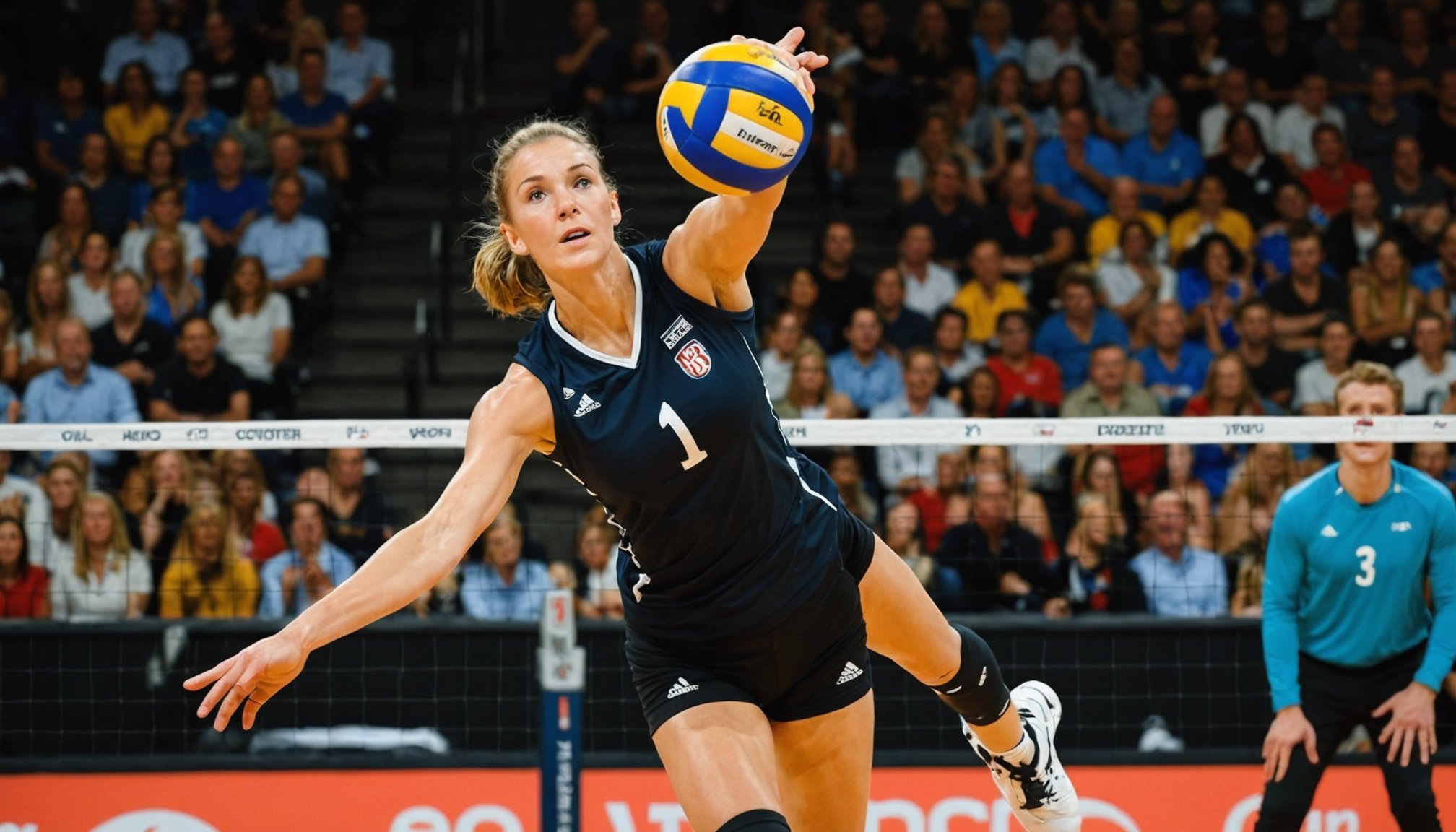Overview of Spiking in Volleyball
Spiking is a pivotal technique in volleyball that can greatly enhance a team’s competitive edge. Understanding the mechanics involved in spiking is essential for players aiming to excel in this crucial aspect of the game.
To begin with, the fundamentals of spiking include a sequence of movements that require precision and timing. It starts with the approach run, a carefully calibrated series of steps that help generate the necessary momentum. The jump follows, where the player’s vertical leap plays a significant role, allowing the hitter to reach a height advantageous for delivering a powerful strike.
In the same genre : Top Techniques to Conquer Pre-Race Anxiety for Competitive Runners
Successful spiking also relies on coordinated spiking techniques. This includes the hitting arm’s swing, which should be fast and fluid, ensuring maximum power and accuracy. The player’s hand should contact the ball at the highest possible point, directing it forcefully downward towards the opponent’s court.
Furthermore, physical attributes play a crucial role. Players need to possess strong legs for explosive jumps and a robust core to maintain balance during the spike. Flexibility and shoulder strength are also important to execute the swinging motion effectively. Mastery of these volleyball mechanics and attributes can distinguish an exceptional spiker from the rest.
In parallel : Top Strength Training Moves Every Pro Rock Climber Should Master
Techniques for Effective Spiking
In the exciting world of volleyball, mastering different spiking techniques is essential for any aspiring player. There are a variety of spikes, each with a unique flair and application. The standing spike is fundamental, executed with feet firmly planted, offering control and precision. Meanwhile, the approach spike involves a running start, unleashing more power and height to the attack. The back row spike challenges players to attack from the backcourt, showcasing tactical acumen and adaptability.
A powerful spike hinges on several crucial elements. Timing is paramount; hitting the ball at the peak of the jump maximizes force. The angle of the spike can strategically target weaker spots on the opponent’s court, while the follow-through impacts the ball’s speed and direction.
Hand positioning is integral; a wide-open hand ensures ample surface area for contact, while a firm wrist adds stability. The subtle wrist motion can impart spin, deceiving defenders and making the ball difficult to predict. To finesse these advanced spiking methods, players must practice diligently, embracing both precision and power to enhance their arsenal of volley spike strategies.
Footwork and Body Positioning
Understanding the intricacies of volleyball footwork and body positioning is crucial for any player looking to master the art of spiking. Proper footwork sets the stage for a successful spike, providing the stability and momentum needed to execute the move effectively.
Footwork leading up to the spike involves a series of calculated steps, typically starting with a three-step or four-step approach. A three-step approach usually involves stepping with the foot opposite to the hitting arm, the next foot, and finally a strong step with the hitting foot. This sequence ensures the player is balanced and holds optimal weight distribution before leaping.
Body positioning is equally important, as it influences the spike’s effectiveness. A player should maintain an upright position with shoulders square to the net while preparing for the spike. At the moment of jumping, the player’s torso should rotate slightly, aligning with the direction of the ball and extending the hitting arm for the strike.
Regular drills are essential for honing these skills. Side shuffles and ladder drills can significantly improve footwork agility, while wall or partner drills can enhance body alignment during the spike. Practising these techniques is key to becoming a skilled and strategic volleyball player.
Drills for Practicing Spiking Skills
Focusing on spike drills can significantly enhance your volleyball performance. For varying skills levels, it is important to tailor the drills to match the current ability of the player. Beginners often benefit from standing spike drills, allowing them to concentrate on form and technique, rather than vertical jump. Intermediates should transition towards agility drills, which increase footwork speed and positioning accuracy, both critical for spiking efficiency. Advanced players excel with more complex drills like approach jumps, combining agility with timing and power.
To boost power and accuracy creatively, one might incorporate resistance bands or weighted balls in spiking routines. This extra resistance can elevate muscle strength and speed. Incorporating target-focused drills using different-sized hoops or placements around the court can improve precision and tactical awareness.
Integrating spiking practice into regular training sessions demands strategic planning. Begin sessions with fundamental drills to reinforce muscle memory. Progress towards volleyball practice sessions that simulate game situations, challenging players to apply their spiking skills under pressure. Lastly, allocate time for retrospective analyses, encouraging players to understand and improve their own techniques based on performance insights gathered during these drills.
Common Mistakes in Spiking
In volleyball, spiking mistakes can significantly impact a player’s performance on the court. Awareness of these common errors is the first step toward improvement.
One of the most frequent mistakes is incorrect footwork. Without proper positioning, players might find themselves off-balance, making it difficult to execute an effective spike. Another typical error involves an improper arm swing, where players either swing too early or too late, significantly reducing the shot’s power and accuracy. Poor timing can also be detrimental, as hitting the ball too high or too low on its arc affects control and strength.
The consequences of these mistakes can be quite noticeable. Poor spiking technique not only reduces a team’s ability to score efficiently but can also negatively influence a player’s confidence and overall gameplay strategy. Furthermore, consistently incorrect spiking can lead to unnecessary fatigue and potential injuries due to improper movement mechanics.
To correct these errors, players should focus on improvement tips such as practicing the right footwork drills, synchronising their approach with the ball’s trajectory, and refining their arm swing technique. Regular feedback from a coach, along with video analysis, can also help players identify and rectify specific mistakes, leading to more successful spikes and improved gameplay.
Measuring Improvement Over Time
For players eyeing consistent growth, understanding performance assessment is crucial. By regularly engaging in spike analysis, players can gauge their spiking trajectory effectively. This involves using specific tools and metrics that highlight areas for improvement and showcase the progress achieved.
One such tool is video analysis, which plays a pivotal role in refining spiking techniques. Through detailed playback and examination, players can identify the nuances of their form, from arm swing to foot positioning. By breaking down these movements, they can make targeted adjustments, leading to enhanced performance on the court.
Aside from technical assessments, setting personal goals is instrumental in self-improvement. Establishing clear objectives allows players to track their development over time and provides a structured roadmap for achieving skill enhancement. For example, if a player aims to increase their spike success rate by a certain percentage, they can periodically review their footage and spikes to ensure they’re on track.
By consistently evaluating performance and technique, players not only boost their development but also build confidence. With tools like video analysis and a focus on personal goals, monitoring and optimizing performance becomes an engaging and rewarding process.
Tips from Experienced Players
Gaining volleyball tips from seasoned players and coaches can significantly enhance your game. These veterans of the sport offer invaluable insights that go beyond basic techniques. For instance, expert advice often emphasizes the importance of mastering both physical and mental aspects of volleyball.
One invaluable piece of advice is the power of mental preparedness. Experienced players highlight the necessity of visualizing successful spikes and plays, which can greatly improve your performance. By mentally rehearsing each move, players are better equipped to execute them under pressure. This foresight aids in boosting confidence on the court.
Additionally, personal anecdotes from accomplished players can be a wellspring of motivation. They often share stories of overcoming challenges and pushing through difficult moments, reminding aspiring players that persistence is key. These player insights are not just motivational but also serve as practical lessons in resilience and adaptability.
Quotes from coaches can further inspire by focusing on discipline, teamwork, and strategy. A common thread among these insights is the belief in continuous improvement and the pursuit of excellence. Taking this wisdom to heart, players can develop a robust mindset that not only enhances their skills but also enriches their overall sporting experience.











